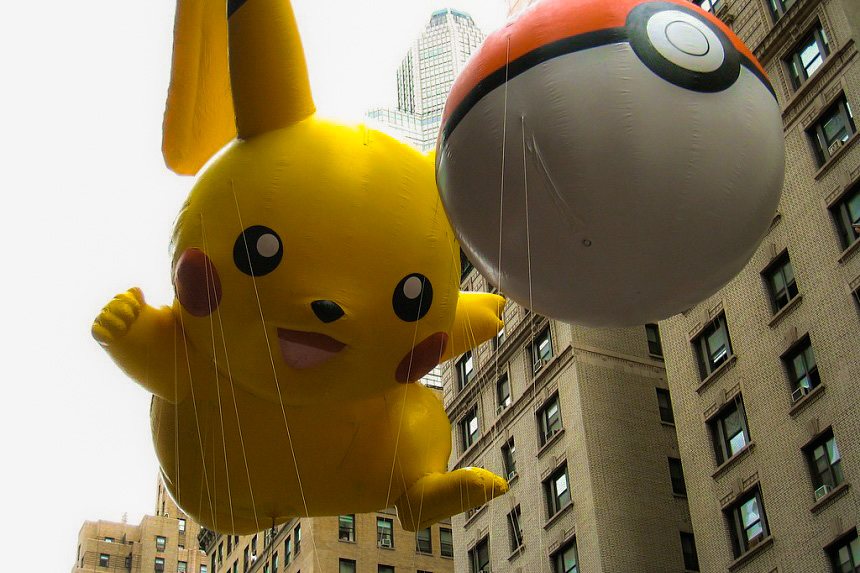From the time those cute, colorful monsters first entered our lives, it seemed that Pokémon was a problem.
Most of my second-grade class was obsessed with collecting the cards and playing the Game Boy games. Everyone had a favorite Pokémon, and choosing Pikachu was a cop-out and meant you weren’t a dedicated Pokémon trainer. My favorite was Vaporeon, a majestic cat-dolphin creature. We were in our own little world, one in which surreal animals were waiting in tall grasses to be caught and trained for battle.
In the real world, teachers took notice of this considerable distraction, and all Pokémon paraphernalia was banned from the school. Parents were concerned — or just annoyed — with how great a presence these creatures had in our lives. The franchise even posed physical threats to children. In 1997, the television show went on a four-month hiatus in Japan after reportedly causing hundreds of children to experience seizures during a climactic scene in which red and blue lights flashed quickly onscreen. In 1999, Burger King reluctantly recalled its Pokéball toys after a young girl suffocated in California from covering her nose and mouth with one.
Each crisis brought about parental hysteria, but Pokémania persisted. In a 1999 TIME article, Howard Chua-Eoan and Tim Larimer bemoaned the phenomenon and its lessons of ravenous accumulation: “Is Pokemon payback for our get-rich-quick era — with our offspring led away like lemmings by Pied Poke-Pipers of greed? Or is there something inherent in childhood that Pokemania simply reflects?” No one could be sure why this Japanese game took the youth by storm, but plenty of cultural commenters were certain about its lack of staying power. It was “the most effortless Japanese invasion of western pop culture since Mighty Morphin Power Rangers,” Peter Bradshaw wrote in The Guardian. It was a fad, they said.
They were wrong.
One of the misconceptions about the explosive wave of pocket monsters was that the whole sensation was generated into existence by executives looking to sell plush toys. While the merchandising didn’t hurt Pokémon’s potential, it was actually created as a passion project by a bug collector outside Tokyo. Satoshi Tajiri grew up catching beetles with his friends in the quickly urbanizing Machido, Japan. He saw the development of Nintendo’s Game Boy and dreamed up a world inside the console where players could catch and trade creatures using the new connecting device: the link cable. He worked on the concept for six years, inventing an expansive map of towns, caves, and seas a player could navigate to find and capture a miscellany of 150 monsters to train and battle.
More than two decades later, there are 812 Pokémon. The latest movie in the franchise, Pokémon Detective Pikachu, had a $58 million opening weekend in the U.S., the biggest ever for any movie based on a video game. Of course, the odd scandal that seems to follow Pokémon has kept up as well. In Montreal, a theater accidentally played the disturbing horror film The Curse of La Llorona instead of the new Pikachu movie to a crowd of crying children.
Pokémon’s astoundingly resilient popularity is clear, if somewhat surprising to those who have never experienced the accomplishment of catching the elusive and powerful Mewtwo. Part of the reason it has such staying power is the fully realized, imaginative world that the characters and their creatures inhabit. In the games, players are able to role play in that world and spend hours on a personalized adventure that combines competition with collaboration.
As children, we would often express the wish that Pokémon were real, and that we could play the game in the real world. Then, in 2016, The Pokémon Company partnered with Google startup Niantic to release Pokémon Go, an augmented reality game in which players catch Pokémon on their smartphones by walking around parks, monuments, and especially Starbucks. The creatures appear against the backdrop of a live video taken by the phone to give the illusion that a Rattata or an Oddish is actually standing before the player.
The summer of 2016 saw children and adults alike playing the game in droves. College campuses, urban walkways, malls, and hospitals were all transformed into Pokéworlds as trainers sauntered about trying to “catch ’em all.” Just as Pokémon had, years before, been deemed a fad, the free app gained the same reputation as it swept the world that summer. Although the number of Pokémon Go players tapered off later that year, the game was still in the top five gaming apps by number of users last October. Last month, Pokémon Go reached one billion downloads.
Two of those downloads were mine. I got the game as a lark during the summer of 2016, then redownloaded it last year when I was ready to get serious. Not quite play-while-driving serious, but serious enough to take over some gyms and catch a Vaporeon.
Everyone has heard about the dangers associated with the game: robberies, car accidents, gaming addiction. But after it was released, Pokémon Go also generated a substantial amount of attention from the academic world. Study after study dissected the phenomenon for its usefulness in education, child psychology, sociology, and even philosophy. While some saw the game only for its dystopian implications on public life, researchers realized how it could benefit conservation efforts, STEM and literacy education, and exercise rates in young people.
In a paper from Russian Education & Society, the authors praise the possibilities of augmented reality gaming: “This game has strengthened the effects of social interaction, giving them a larger scale, dynamism, and influence. According to UNESCO, these trends have colossal educational potential.” Pokémon Go has led the way in its ability to merge the physical, social, and virtual aspects of gaming. A study in the American Journal of Public Health showed that “playing Pokémon Go increased moderate to vigorous physical activity by about 50 minutes per week and reduced sedentary behavior by about 30 minutes per day,” and a call for qualitative studies on the subject claims “sustained and regular use of the app stands to improve not only physical activity but also mental health, social capital, and social interactions in these key populations [teens, preteens, and younger men].” It might have been disheartening to watch an inflatable couch-ridden preadolescent logging hours and hours of Pokémon Red Version on a Game Boy in 1999, but the same criticisms are hardly applicable in this new era of active, engaged Pokémon hunting.
In 1999, TIME interviewed Satoshi Tajiri about his creation, asking why Pokémon was so popular. He answered, “When you’re a kid and get your first bike, you want to go somewhere you’ve never been before. That’s like Pokémon. Everybody shares the same experience, but everybody wants to take it someplace else.”
My own experience with Go was as nostalgic as it needed to be and novel enough to be exciting. Though I have to admit my disappointment with the concepts of some of the newer monsters — one is a balloon and another is an actual bag of trash — the magical thoroughness of the Pokémon world holds up. I even took second (and third) looks at the monuments surrounding a nearby park as I would walk my dog, since they were also virtual Pokéstops that harbored the necessary Pokéballs.
Does this mean I’ll be buying tickets to the new movie? Attending the Pokémon Go Fest in Chicago this June? It’s not likely. But plenty of others will, and the “fad” will live on.
Image by Traci Lawson on Flickr, edited.
Become a Saturday Evening Post member and enjoy unlimited access. Subscribe now




Comments
Well, the headline might fill me with joy if I’d kept the Pokémon stuff I bought for my 2 nephews (ages 5 & 7 in 1999) for MYSELF in the original boxes, unopened. Instead, I bought and gave them to those two boys who wrecked them on my sister’s minivan floor 20 years ago. “You’re a couple of brats, the both of you!” Not a thank you or a hug for my efforts at McDonald’s or Toys ‘R’ Us. It wasn’t easy finding a shady parking spot!
(I said to my wife at the time, “Can you imagine me, a father?” which was quickly answered by “frankly, no!”)
So the headline kind of fills me with dread since I didn’t do that. I’ve got unopened LP’s like ‘Dark Side of the Moon’ and ‘The Grand Illusion’ unopened, in their bags, with the original receipts. The latter WAS purchased on the day of release, 7/7/77 to boot. Am I fooling myself thinking they have value? No, they do. I did get to meet the still beautiful former Miss America, Lee Meriwether, last Fall at the Westin near LAX. Wonderful lady.
No Pokémon stuff in my storage, no. I’ve got 10 of the amazing, fun Taco Bell Dogs unopened in the plastic from ’98 & ’99. They still talk too when you press their bellies: “Groowooool” and “How cool is this?” Very cool my terrific little late ’90s Chihuahua advertising icons, regardless of your worth!